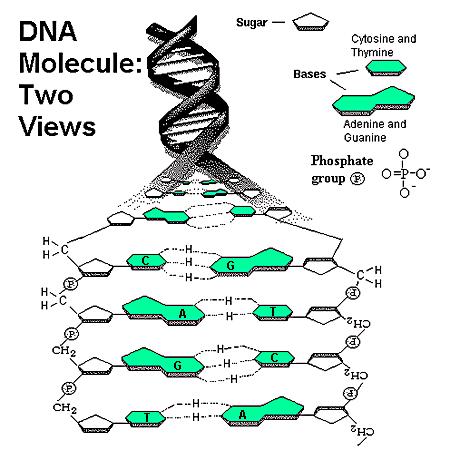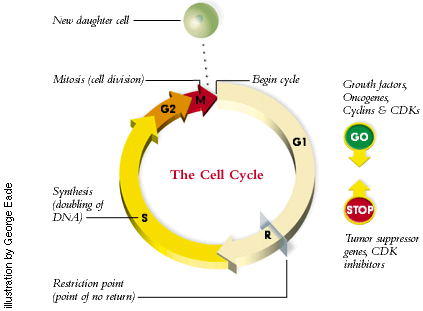

What
is DNA?
(a
brief introduction / review)
| DNA (deoxyribonucleic acid) is the basic genetic material of all life on earth. |
| (although prions and some viruses do not contain DNA, they are not generally considered to be alive) |
|
|
| It
is a long thread-like molecule in the form of a double helix, which looks
something like an immensely long ladder twisted into a coil. The
sides of the "ladder" are formed by a backbone of sugar (deoxyribose) and
phosphate molecules, and the "rungs" consist of nitrogenous bases joined
weakly in the middle by hydrogen bonds.
- there are four different nitrogenous bases in DNA (A, G, C and T)
|

This diagram was obtained from the graphics gallery at Access Excellence |
|
|
Transcription and Translation
| DNA consists of coding and
non-coding
regions
coding regions (genes)
Transcription:
Translation:
non-coding regions
contain many regulatory sequences
|

This diagram was obtained from the graphics gallery at Access Excellence
|
Transcription coupled repair (TCR) vs. Global genome repair (GGR)
|
Many types of damage can interfere with RNA transcription by inhibiting the progression of RNA polymerase along active genes. As the ability to produce new proteins is important for cell survival, it is essential that such damage is rapidly removed. Consequently, DNA repair mechanisms which are responsible for removing these types of damage (nucleotide excision repair (NER) and base excision repair (BER)) rapidly identify stalled RNA polymerases and repair the corresponding damage, allowing the RNA polymerase to continue transcribing the gene. As RNA polymerases only "read" one of the two DNA strands of active genes, only this "transcribed strand" is repaired by the transcription-coupled repair (TCR) pathway. Both NER and BER pathways also contain other proteins which can directly recognise DNA damage. While this process is not as rapid as TCR, it identifies DNA damage throughout the entire genome (regardless of transcriptional activity), and is termed global genome repair (GGR). The combination of these two mechanisms (TCR and GGR) allows for a very rapid, preferential repair of the transcribed strand of active genes with a slower, but still very efficient repair of the remainder of the genome.
|
| TCR processes are discussed in more detail for both prokaryotes (bacteria) and eukaryotes (higher organsims). |
|
|
Cell cycle
| Some DNA repair pathways (such as DSB
repair) are limited to certain phases of the cell cycle.
The cell cycle is the "program" for cell growth and cell division (proliferation). There are 4 broad phases of the cell cycle: G1, S, G2, and M (see figure).
|

This figure obtained from Cell Cycle Regulation. |
|
G1 is a phase of protein synthesis in which the cell recovers from the previous division and readies itself for the subsequent phase of DNA replication. Additionally, G1 contains "checkpoints", in which it checks itself over to ensure that it is in good condition to continue dividing. If conditions exist (such as the presence of DNA damage) under which it is inappropriate for the cell to continue growing/dividing these checkpoints prevent the continuation of the cell cycle (termed cell cycle arrest). |
|
S (DNA synthesis) phase is when the cell replicates its DNA (see top panel of "Central Dogma of Molecular Biology" figure above). This is essential so that both daughter cells will contain identical DNA. |
|
G2 is another phase of protein synthesis in which the cell recovers from DNA synthesis and prepares itself for mitosis and cell division. G2 also contains DNA damage sensitive checkpoints. |
|
M (mitosis) is the separation of the newly replicated DNA (see S phase) to opposite poles of the cell. This is followed immediately by cytokinesis (splitting of the cell into two identical daughter cells, each containing one copy of the parental cell's DNA). For more information see: Cell Cycle Regulation. |
|
|
